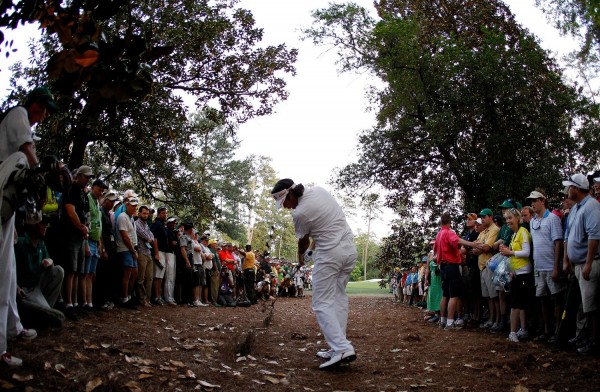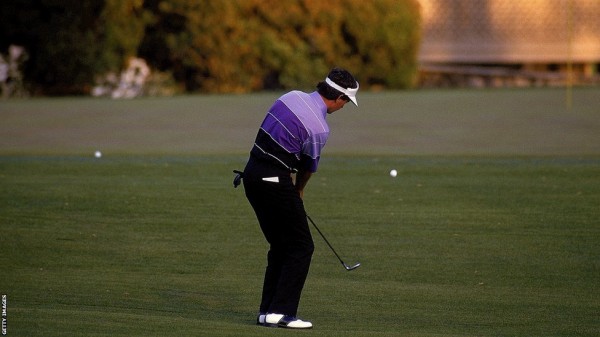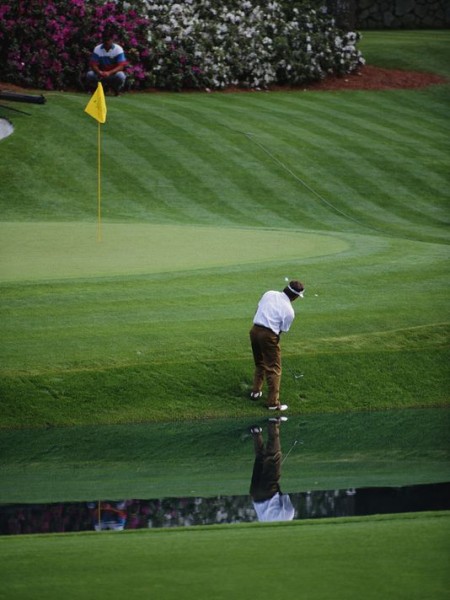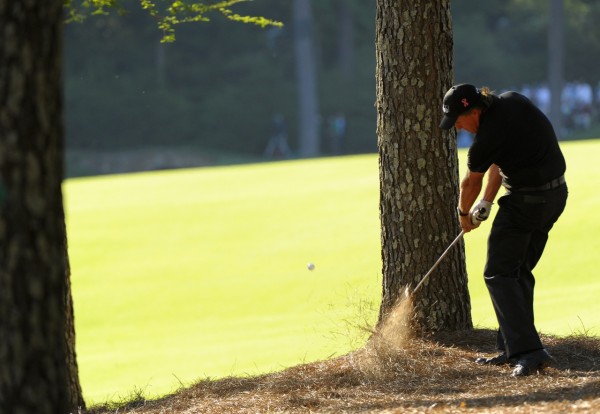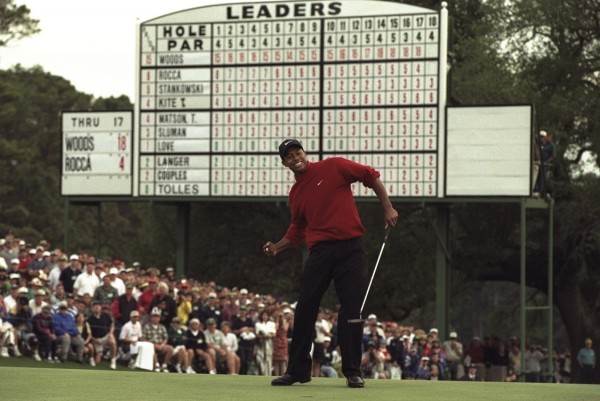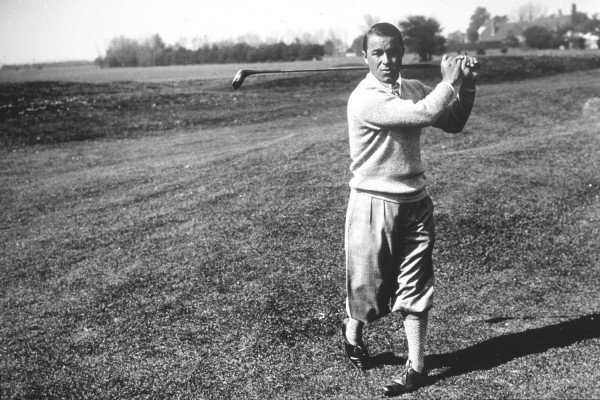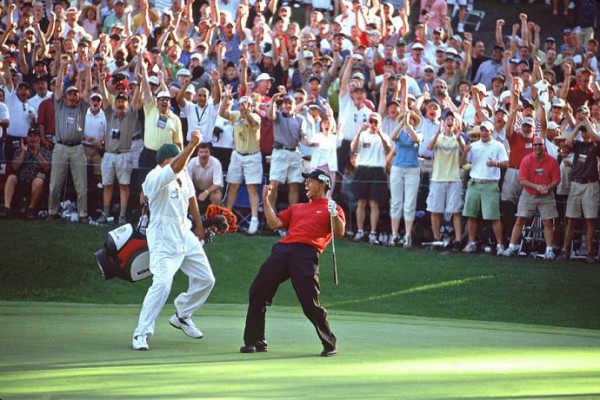Opinion & Analysis
Hole-By-Hole: The Best and Worst Shots in Masters History (Back 9)
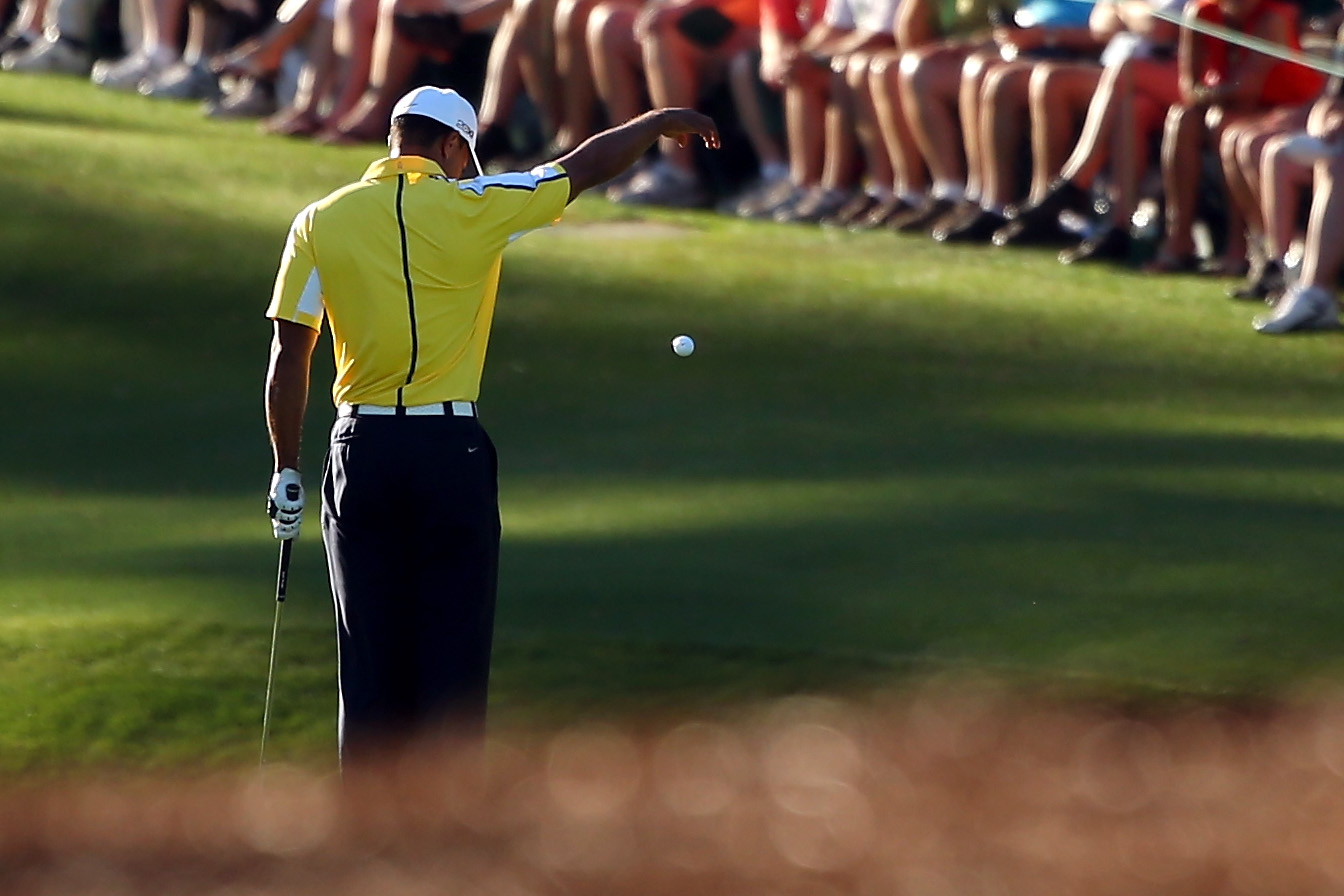
Everyone has their favorite moments from the Masters. But what are the best and worst shots in Masters history for each hole at Augusta National?
From shots that directly impacted the outcome of the tournament, to others that were impossibly shocking, miserable, or symbolic in their own right, every hole has a story to tell.
77 years, over 3,000 different players, and more than one million shots taken. These are the legendary bests and worsts forever etched in Masters lore.
Related: Hole-By-Hole: The Best And Worst Shots In Masters History (Front 9)
No. 10: Camellia – Par 4, 495 yards
The Best
Bubba Watson is a self-described new age redneck. He raps in golf videos, drives the “General Lee” and flies around the golf course in a hovercraft. So it shouldn’t be surprising he dared to even imagine the Looney Tunes shot he pulled off on the second playoff-hole of the 2012 Masters.
Watson was deep in the woods on No. 10 after an errant tee shot. His ball nestled in a bed of straw in a place where Augusta’s pines looked like monsters from Sleepy Hollow. Watson couldn’t even see the green, but he stepped up and just bludgeoned his wedge. The ball screamed 40 yards through the trees, snap-hooked right and soared 115 yards in the air before plummeting softly on the green. Watson then two-putt for par to become the 76th Masters champion.
Watson put himself in position to win on the strength of consecutive birdies on Nos. 13 through 16. But it was his shot at No. 10 that everyone wanted to talk about afterward, including Bubba.
“I’m obviously going to say I’m the only one who can do it,” Watson said. “I’m the only one who had a chance to do it.”
Call that bravado. Call it a Bubba-ism. Watson is a Masters champion with a style as bold as his swing.
The Worst
Scott Hoch was 24 inches from Masters immortality on the first playoff hole of the 1989 Masters. Twenty-four inches from breakfast in the Masters Champions Locker Room. Twenty four agonizing inches, but that might as well been 24 feet.
Hoch greased his Green Jacket gimme entirely outside the hole and 4 feet beyond. It was the shortest putt missed with a chance to win any major championship in history. And when Hoch launched his putter 10 feet in the air, he became the Masters poster boy for putter paralysis.
It was more painful than childbirth to watch. And Hoch said after the playoff, “I’m just glad I don’t carry a gun with me.” Nick Faldo made his 25-foot birdie putt on the next playoff hole and went home as the 53rd Masters champion. Hoch just went home.
No. 11: White Dogwood – Par 4, 505 yards
The Best
The 51st Masters was a modern-day tale of David and Goliath. Larry Mize was a relative unknown, a local kid who ran the scoreboard during the 1972 Masters. Greg Norman was golf’s most dominant player, ranked No. 1 in the world. And with one deadly sling of his wedge in a sudden-death playoff, Mize dropped the giant Norman to his knees.
Initially a three-man playoff, World No. 3 Seve Ballesteros was eliminated on the previous hole. And on No. 11 Norman reached the green first, leaving Mize a choice between playing it safe or going for the jugular. The fresh-faced Mize went for the kill.
Taking aim at the front edge of the green, Mize chipped towards a grassy bank. The ball bounced twice before catching the slope. Then it broke straight for the hole. And when it finally dropped in the cup, Norman was out on his feet.
Mize chipped in from 140 feet, delivering one of the most absurdly fantastic shots in Masters history. The crowd went berserk. Mize danced in disbelief. And the hometown hero became an Augusta legend in 1987.
The Worst
Ben Hogan had a well-documented blueprint for playing “White Dogwood” in 1954. Always aim the approach towards the right fringe of the green. Anything left was too risky with the greenside pond. But in the final round of the 18th Masters, Hogan deviated from the plan and it cost him a potential third Green Jacket.
Hogan heard a tremendous roar from the crowd two groups ahead, and presumed his lead had diminished. So Hogan uncharacteristically fired at the flag and the result was disastrous. Rather than recording par or birdie like he did in the first three rounds, Hogan took a double-bogey six when his ball found the pond.
Hogan lost in an 18-hole playoff with Sam Snead the following afternoon. But that roar from the crowd on Sunday? It wasn’t an eagle roar, or even a birdie roar. It was a roar of approval for a player who went barefoot into Rae’s Creek searching for an errant shot.
No. 12: Golden Bell – Par 3, 155 yards
The Best
Every Masters champion has to successfully navigate “Amen Corner” on Sunday if he’s going to wear the Green Jacket. And at the 56th Masters in 1992, Fred Couples survived this rite of passage with the help of something supernatural.
Couples held a three stroke lead heading towards the treacherous No. 12. But when his tee shot came up short and hit the sloping bank of Rae’s Creek, Couples’ dreams of winning the Masters were about to wash away.
There was really no reason Couples’ ball should have stopped. Nothing was in its way: nothing that anyone could see that is. Ninety nine out of 100 times that ball winds up in a watery grave, but miraculously it held on.
“The biggest break probably of my life,” Couples said afterward.
Couples chipped up to inside a foot and held on to win his first major by two strokes. But Augusta officials could have stopped the tournament right there and declared Couples the winner. His ball was touched by an angel.
The Worst
Tom Weiskopf was known on Tour as “The Towering Inferno.” By Weiskopf’s own admission, he was “spontaneous with his emotions.” And during the opening round of the 44th Masters at No. 12, Weiskopf threw a match in the gas tank.
Weiskopf’s tee shot hit the green, skipped forward and then spun like a Ninja Blender down the bank to drown into Rae’s Creek. Weiskopf dropped from 60 yards and the result was an exact copy of the first. Hop, skip and dunk. Then Weiskopf started percolating. He detonated his third shot in the center of the creek, splashed his fourth shot with a direct-hit and drenched his fifth shot with mainstream perfection.
In the 1980 Masters Weiskopf hit five shots into the water in about a five-minute span, en route to a record-setting 13 on No. 12. And, oh by the way? In Weiskopf’s previous 12 Masters appearances he didn’t hit a single ball in the water on No. 12.
No. 13: Azalea – Par 5, 510 yards
The Best
When your ball is on pine straw and there are two gigantic trees in front of you, the percentage play is to lay up and avoid the big number. But for Phil Mickelson in the final round of the 2010 Masters, the play was to thread the needle and sew up his third Green Jacket.
Greatness or fate took over on No. 13 when Mickelson hooked his 6-iron through the trees, over Rae’s Creek, to four feet from the cup. Mickelson missed his eagle attempt but sunk the birdie. And Mickelson’s one-stroke lead suddenly became a more comfortable two-stroke lead. Mickelson didn’t have to hit that shot. And maybe he shouldn’t have. But “Phil the Thrill” wanted to.
“A great shot is when you pull it off,” Mickelson said afterwards. “A smart shot is when you don’t have the guts to try it.”
It’s hard to argue with that when the guy saying it just won the 74th Masters.
The Worst
Tommy Nakajima was a fierce competitor on the Japanese Tour in 1978. But a comedy of errors in the first round of the 42nd Masters led to Nakajima posting the highest score ever recorded on “Azalea.”
Nakajima’s drive at No. 13 sailed into the woods and forced him to take an unplayable. After Nakajima laid up, his fourth shot flew into Rae’s Creek. Not wanting to take another unplayable, Nakajima hit from the creek and popped the ball in the air. It landed on Nakajima’s foot for a two-stroke penalty.
Nakajima’s next shot hit the creek bank and rolled back where he was standing. The ball didn’t hit Nakajima this time. But Nakajima slammed his club on the water in frustration and was slapped with a two-stroke penalty for grounding his club in a hazard.
Nakajima finally chipped out onto the green, and two-putted to close the book on No. 13 with a perplexing 13. When asked after the round where it all went wrong, Nakajima simply replied, “On the tee.”
No. 14: Chinese Fir – Par 4, 440 yards
The Best
The greatest moment in the history of No. 14 came during the final round of the 1997 Masters when Tiger Woods’ birdie changed the game forever.
Woods’ birdie established a new Masters record for lowest tournament score (270, 18-under). It also set a new Masters record for largest margin of victory (12 strokes) and punctuated Woods’ dominance as the youngest player and first black man to ever win the Green Jacket.
When Jack Nicklaus first set those records in 1965, Bobby Jones said of Nicklaus, “He plays a game with which I am not familiar.” At the 61st Masters, Woods not only played a game with which Nicklaus was not familiar, but he played it in a way that elevated golf to new a cultural plateau.
The Worst
Fred Couples was 46 years old in 2006. He had no trouble keeping up with young guns off the tee. And during the final round of the 70th Masters, Couples hit the ball like a Masters champion. He just didn’t putt like one.
Couples had a four-foot birdie putt on No. 14 to pull within one stroke of leader Phil Mickelson. But he jabbed the putt across the lip and five-feet past the cup. Couples missed his putt coming back for an eventual three-putt bogey.
From tee-to-green, Couples was as good as anyone in the field. But his flat-stick left him sputtering to a third-place finish.
“I didn’t hit the ball like I was 46,” Couples said afterwards. “But I putt like I was 66.”
It was Couples best opportunity for a second green jacket, and would have made him the oldest champion in Masters history.
No. 15: Firethorn – Par 5, 530 yards
The Best
Gene Sarazen knew he caught the ball pure. It left the face like a gunshot and never wavered from its direct line to the pin. When it reached the green, a thunderous roar went up. When it dropped in the cup, the roar was deafening. In the final round of the second Masters in 1935, Sarazen hit “The Shot Heard Round the World.”
Sarazen used a 4-wood from 235 yards to record the first albatross in Masters history. It launched “The Squire” into a 36-hole playoff where Sarazen defeated Craig Wood for his first and only Green Jacket. And most importantly, Sarazen’s double-eagle permanently put the Masters on the map.
Sarazen’s “Do-Do” (that’s what he called his Wilson Turf Rider 4-wood) is in the USGA Museum for generations to marvel at. And in 1955, Augusta National honored Sarazen’s unforgettable shot by dedicating a bridge in his name. “The Sarazen Bridge” is the first bridge to ever be named after a player in Augusta’s history.
The Worst
In 2013, Tiger Woods nearly holed his approach shot for eagle at No. 15. But it hit the flag during the second round of the 77th Masters, and after his ball diabolically caromed off the flag and rolled into the water, Woods’ next shot would become a “Firethorn” in his side.
Woods took his drop and got up-and down for a bogey six, but a television viewer noticed Woods dropped the ball a few yards further back from the pin, a violation of the rule to drop “as close as possible” to the original spot.
Rules officials discussed the drop with Woods, and he admitted to dropping farther back so he wouldn’t hit the flag again. Woods was not disqualified, but a two-stroke penalty was assessed and his score at No. 15 was officially a triple-bogey eight. Woods’ admission set off an ugly storm of controversy, however.
Journalists, commentators, fans and players called for Woods to withdraw for knowingly attempting to circumvent the rules. Woods might have been cheated out of a eagle on No. 15 and a potential fifth Green Jacket, but allegations of Woods cheating himself was the biggest character test of all.
No. 16: Redbud – Par 3, 170 yards
The Best
Tiger Woods was in a final-round battle with Chris DiMarco at the 69th Masters in 2005. And Woods appeared wounded on No. 16 when his 8-iron missed the green long and left. Woods couldn’t take dead-aim at the hole because of the severe slope of the green, but that didn’t mean Woods wouldn’t attack the cup.
Woods picked a spot 25-feet left of the pin and chipped. His ball checked up, broke right and picked up speed toward the hole. Then it slowed to a dead stop… for two seconds. It was golf’s version of the Heisman pose before crossing the goal line. Woods’ ball freakishly dropped over the edge for an impossible birdie.
Woods roared like a gladiator and the crowd went berserk. It took several minutes before any semblance of normalcy returned. Woods ultimately needed a playoff to defeat DeMarco and capture his fourth green jacket. But “in your life…” You know the rest.
The Worst
Greg Norman is the most heartbreaking character in Masters history. And Norman’s legendary low-point occurred in the final round of the 60th Masters.
Norman began play with a six-stroke lead over Nick Faldo, but when Norman arrived at No. 16 it had decomposed into a two-stroke deficit. With only three holes left to get those strokes back, Norman fired at the pin hoping for an ace. Instead he butchered his 6-iron into the water.
In 1996, Norman blew the biggest final-round lead in Masters history. And his 6-iron on No. 16 was the “recognition” of this “Greek Tragedy.”
No. 17: Nandina – Par 4, 440 yards
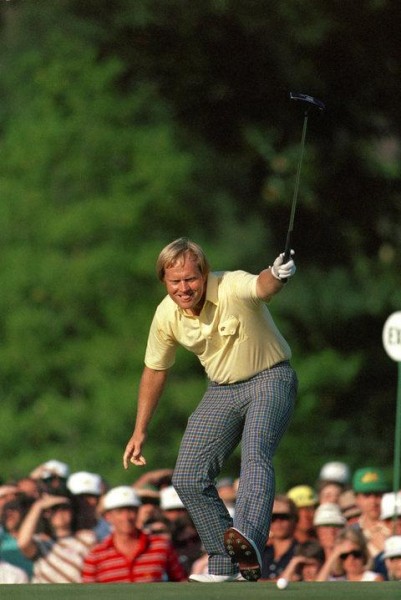
The Best
When Jack Nicklaus arrived at Augusta National for the 50th Masters in 1986, no one gave him any chance of winning. Nicklaus was 46-years old and past his prime, but he was able to roll back the years. And then on No. 17 he rolled in the putt.
Nicklaus found himself locked in a dogfight with Greg Norman, Bernhard Langer, Seve Ballesteros and Tom Kite to start the back-9. But he separated himself from Norman and Langer with a birdie at No. 13, an eagle at No. 15 and another birdie at No. 16. Nicklaus’ charge on the back nine was the greatest stretch of competitive golf ever played.
Then on No. 17, tied for the lead with Ballesteros and Kite, Nicklaus sank the most famous putt in Masters history.
Staring down a double-breaking 12-foot putt with a train whistle screaming in the background and the opportunity for Nicklaus to grab sole possession of the Masters lead for the first time in 11 years, Jack’s killer instinct took over.
Nicklaus gently stroked his mammoth putter, raised his left arm triumphantly in the air and chased his ball down the hole for birdie. He became a a six-time Masters champion, and the signature moment was Jack’s magical putt on No. 17.
The Worst
Stuart Appleby enjoyed a four-stroke advantage to start the third round of the 71st Masters in 2007, but on No. 17 the “Eisenhower Tree” issued a high-command resignation of Appleby’s lead.
Appleby pulled his tee shot so far left it flew over the famous pine and into a greenside bunker one fairway over. Applbey then caught his 9 iron thin out of the bunker and dropped it in a stockpile of pine cones.
It took Appleby two more shots to reach the green, and after he three-putt for a very un-presidential triple-bogey, Applbey said, “Stuff like that happens. That’s Augusta.”
No. 18: Holly – Par 4, 465 yards
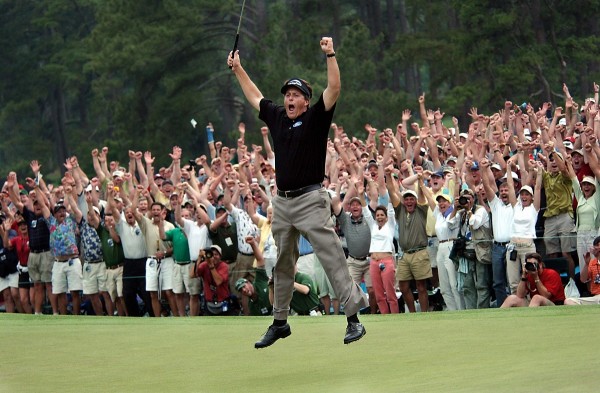
The Best
Phil Mickelson came into the 68th Masters needing a major resuscitation. He was an agonizing 0-for-11 in previous Masters appearances. And in 2004, Mickelson’s putt on No. 18 proved to be a real heart-stopper.
A 20-foot birdie putt on No. 18 was the only thing standing between Mickelson and his first Masters championship, but the odds were not in his favor. Only five players in Masters history had birdied the 72nd hole to win the Green Jacket.
Mickelson’s putt looked like it was going to barely miss left, but it caught a piece of the lip, circled around the hole and dropped in. And Mickelson… well, he hopped.
Maybe the relief of finally winning a major got the best of Mickelson. His jump for joy wasn’t exactly gravity-defying, but it was a Mickelodean moment hard to top in the putt-making celebration category.
The Worst
Arnold Palmer strolled up the fairway during the final round of the 25th Masters confident in his third green jacket coronation. All Palmer had to do was par No. 18 like he’d done the previous three rounds, but “The King” put his head on a chopping block.
Palmer pushed his approach right into the greenside bunker. Then he skulled his bunker shot across the green and into the gallery. Palmer’s next shot raced 15 feet past the hole, and finally Palmer missed a putt that would have at least forced a playoff.
It was a brutal turn of events for Palmer, who finished one stroke behind Masters champion Gary Player. Palmer would still go on to win two more Green Jackets, but in 1961 “The King” could not escape the guillotine.
- LIKE0
- LEGIT0
- WOW2
- LOL0
- IDHT0
- FLOP0
- OB0
- SHANK0
19th Hole
Vincenzi’s 2024 Wells Fargo Championship betting preview: Tommy Fleetwood ready to finally land maiden PGA Tour title

The PGA Tour season ramps back up this week for another “signature event,” as golf fans look forward to the year’s second major championship next week.
After two weaker-field events in the Zurich Classic and the CJ Cup Byron Nelson, most of the best players in the world will head to historic Quail Hollow for one of the best non-major tournaments of the year.
Last season, Wyndham Clark won the event by four shots.
Quail Hollow is a par-71 measuring 7,521 yards that features Bermudagrass greens. The tree-lined, parkland style course can play quite difficult and features one of the most difficult three-hole stretches in golf known as “The Green Mile,” which makes up holes 16-18: two mammoth par 4s and a 221-yard par 3. All three holes have an average score over par, and water is in play in each of the last five holes on the course.
The field is excellent this week with 68 golfers teeing it up without a cut. All of the golfers who’ve qualified are set to tee it up, with the exception of Scottie Scheffler, who is expecting the birth of his first child.
Past Winners at Quail Hollow
- 2023: Wyndham Clark (-19)
- 2022: Max Homa (-8)
- 2021: Rory McIlroy (-10)
- 2019: Max Homa (-15)
- 2018: Jason Day (-12)
- 2017: Justin Thomas (-8) (PGA Championship)
- 2016: James Hahn (-9)
- 2015: Rory McIlroy (-21)
Key Stats For Quail Hollow
Strokes Gained: Approach
Strokes gained: Approach will be extremely important this week as second shots at Quail Hollow can be very difficult.
Total SG: Approach Over Past 24 Rounds
- Akshay Bhatia (+1.16)
- Tom Hoge (+1.12)
- Corey Conners (+1.01)
- Shane Lowry (+0.93)
- Austin Eckroat (+0.82)
Strokes Gained: Off the Tee
Quail Hollow is a long course on which it is important to play from the fairway. Both distance and accuracy are important, as shorter tee shots will result in approach shots from 200 or more yards. With most of the holes heavily tree lined, errant drives will create some real trouble for the players.
Strokes Gained: Off the Tee Past 24 Rounds:
- Ludvig Aberg (+0.73)
- Rory McIlroy (+0.69)
- Xander Schauffele (+0.62)
- Viktor Hovland (+0.58)
- Chris Kirk (+0.52)
Proximity: 175-200
The 175-200 range is key at Quail Hollow. Players who can hit their long irons well will rise to the top of the leaderboard.
Proximity: 175-200+ over past 24 rounds:
- Cameron Young (28’2″)
- Akshay Bhatia (29’6″)
- Ludvig Aberg (+30’6″)
- Sam Burns (+30’6″)
- Collin Morikawa (+30’9″)
SG: Total on Tom Fazio Designs
Players who thrive on Tom Fazio designs get a bump for me at Quail Hollow this week.
SG: Total on Tom Fazio Designs over past 36 rounds:
- Patrick Cantlay (+2.10)
- Rory McIlroy (+1.95)
- Tommy Fleetwood (+1.68)
- Austin Eckroat (+1.60)
- Will Zalatoris (+1.57)
Strokes Gained: Putting (Bermudagrass)
Strokes Gained: Putting has historically graded out as the most important statistic at Quail Hollow. While it isn’t always predictable, I do want to have it in the model to bump up golfers who prefer to putt on Bermudagrass.
Strokes Gained: Putting (Bermudagrass) Over Past 24 Rounds:
- Taylor Moore (+0.82)
- Nick Dunlap (+.76)
- Wyndham Clark (+.69)
- Emiliano Grillo (+.64)
- Cam Davis (+.61)
Course History
This stat will incorporate players that have played well in the past at Quail Hollow.
Course History over past 36 rounds (per round):
- Rory McIlroy (+2.50)
- Justin Thomas (+1.96)
- Jason Day (+1.92)
- Rickie Fowler (+1.83)
- Viktor Hovland (+1.78)
Wells Fargo Championship Model Rankings
Below, I’ve compiled overall model rankings using a combination of the five key statistical categories previously discussed — SG: Approach (27%), SG: Off the Tee (23%), SG: Total on Fazio designs (12%), Proximity: 175-200 (12%), SG: Putting Bermuda grass (12%), and Course History (14%).
- Wyndham Clark
- Rory McIlroy
- Xander Schauffele
- Shane Lowry
- Hideki Matsuyama
- Viktor Hovland
- Cameron Young
- Austin Eckroat
- Byeong Hun An
- Justin Thomas
2024 Wells Fargo Championship Picks
Tommy Fleetwood +2500 (DraftKings)
I know many out there have Tommy fatigue when it comes to betting, which is completely understandable given his lack of ability to win on the PGA Tour thus far in his career. However, history has shown us that players with Fleetwood’s talent eventually break though, and I believe for Tommy, it’s just a matter of time.
Fleetwood has been excellent on Tom Fazio designs. Over his past 36 rounds, he ranks 3rd in the field in Strokes Gained: Total on Fazio tracks. He’s also been incredibly reliable off the tee this season. He’s gained strokes in the category in eight of his past nine starts, including at The Masters, the PLAYERS and the three “signature events” of the season. Tommy is a golfer built for tougher courses and can grind it out in difficult conditions.
Last year, Fleetwood was the first-round leader at this event, firing a Thursday 65. He finished the event in a tie for 5th place.
For those worried about Fleetwood’s disappointing start his last time out at Harbour Town, he’s bounced back nicely after plenty of poor outings this season. His T7 at the Valero Texas Open was after a MC and T35 in his prior two starts and his win at the Dubai Invitational came after a T47 at the Sentry.
I expect Tommy to bounce back this week and contend at Quail Hollow.
Justin Thomas +3000 (DraftKings)
It’s been a rough couple of years for Justin Thomas, but I don’t believe things are quite as bad as they seem for JT. He got caught in the bad side of the draw at Augusta for last month’s Masters and has gained strokes on approach in seven of his nine starts in 2024.
Thomas may have found something in his most recent start at the RBC Heritage. He finished T5 at a course that he isn’t the best fit for on paper. He also finally got the putter working and ranked 15th in Strokes Gained: Putting for the week.
The two-time PGA champion captured the first of his two major championships at Quail Hollow back in 2017, and some good vibes from the course may be enough to get JT out of his slump.
Thomas hasn’t won an event in just about two years. However, I still believe that will change soon as he’s been one of the most prolific winners throughout his PGA Tour career. Since 2015, he has 15 PGA Tour wins.
Course history is pretty sticky at Quail Hollow, with players who like the course playing well there on a regular basis. In addition to JT’s PGA Championship win in 2017, he went 4-1 at the 2022 Presidents Cup and finished T14 at the event last year despite being in poor form. Thomas can return as one of the top players on the PGA Tour with a win at a “signature event” this week.
Cameron Young +3500 (DraftKings)
For many golf bettors, it’s been frustrating backing Cam Young this season. His talent is undeniable, and one of the best and most consistent performers on the PGA Tour. He just hasn’t broken through with a victory yet. Quail Hollow has been a great place for elite players to get their first victory. Rory McIlroy, Anthony Kim, Rickie Fowler and Wyndham Clark all notched their first PGA Tour win at Quail.
Throughout Cam Young’s career, he has thrived at tougher courses with strong fields. This season, he finished T16 at Riviera and T9 at Augusta National, demonstrating his preference of a tough test. His ability to hit the ball long and straight off the tee make him an ideal fit for Quail Hollow, despite playing pretty poorly his first time out in 2023 (T59). Young should be comfortable playing in the region as he played his college golf at Wake Forest, which is about an hour’s drive from Quail Hollow.
The 26-year-old has played well at Tom Fazio designs in the past and ranks 8th in the field in Strokes Gained: Total on those courses in his last 36 rounds. Perhaps most importantly, this season, Young is the best player on the PGA Tour in terms of proximity from 175-200 in the fairway, which is where a plurality and many crucial shots will come from this week.
Young is an elite talent and Quail Hollow has been kind to players of his ilk who’ve yet to win on Tour.
Byeong Hun An +5000 (FanDuel)
Byeong Hun An missed some opportunities last weekend at the CJ Cup Byron Nelson. He finished T4 and played some outstanding golf, but a couple of missed short putts prevented him from getting to the winning score of -23. Despite not getting the win, it’s hard to view An’s performance as anything other than an overwhelming success. It was An’s fourth top-ten finish of the season.
Last week, An gained 6.5 strokes ball striking, which was 7th in the field. He also ranked 12th for Strokes Gained: Approach and 13th for Strokes Gained: Off the Tee. The South Korean has been hitting the ball so well from tee to green all season long and he now heads to a golf course that should reward his precision.
An’s driver and long irons are absolute weapons. At Quail Hollow, players will see plenty of approach shots from the 175-200 range as well as some from 200+. In his past 24 rounds, Ben ranks 3rd in the field in proximity from 175-200 and 12th in proximity from 200+. Playing in an event that will not end up being a “birdie” fest should help An, who can separate from the field with his strong tee to green play. The putter may not always cooperate but getting to -15 is much easier than getting to -23 for elite ball strikers who tend to struggle on the greens.
Winning a “signature event” feels like a tall task for An this week with so many elite players in the field. However, he’s finished T16 at the Genesis Invitational, T16 at The Masters and T8 at the Arnold Palmer Invitational. The 32-year-old’s game has improved drastically this season and I believe he’s ready to get the biggest win of his career.
- LIKE2
- LEGIT0
- WOW0
- LOL0
- IDHT0
- FLOP0
- OB0
- SHANK0
19th Hole
Vincenzi’s LIV Golf Singapore betting preview: Course specialist ready to thrive once again

After another strong showing in Australia, LIV Golf will head to Sentosa Golf Club in Singapore looking to build off of what was undoubtedly their best event to date.
Sentosa Golf Club sits on the southern tip of Singapore and is one of the most beautiful courses in the world. The course is more than just incredible scenically; it was also rated 55th in Golf Digest’s top-100 courses in 2022-2023 and has been consistently regarded as one of the best courses in Asia. Prior to being part of the LIV rotation, the course hosted the Singapore Open every year since 2005.
Sentosa Golf Club is a par 71 measuring 7,406 yards. The course will require precise ball striking and some length off the tee. It’s possible to go low due to the pristine conditions, but there are also plenty of hazards and difficult spots on the course that can bring double bogey into play in a hurry. The Bermudagrass greens are perfectly manicured, and the course has spent millions on the sub-air system to keep the greens rolling fast. I spoke to Asian Tour player, Travis Smyth, who described the greens as “the best [he’s] ever played.”
Davis Love III, who competed in a Singapore Open in 2019, also gushed over the condition of the golf course.
“I love the greens. They are fabulous,” the 21-time PGA Tour winner said.
Love III also spoke about other aspects of the golf course.
“The greens are great; the fairways are perfect. It is a wonderful course, and it’s tricky off the tee.”
“It’s a long golf course, and you get some long iron shots. It takes somebody hitting it great to hit every green even though they are big.”
As Love III said, the course can be difficult off the tee due to the length of the course and the trouble looming around every corner. It will take a terrific ball striking week to win at Sentosa Golf Club.
In his pre-tournament press conference last season, Phil Mickelson echoed many of the same sentiments.
“To play Sentosa effectively, you’re going to have a lot of shots from 160 to 210, a lot of full 6-, 7-, 8-iron shots, and you need to hit those really well and you need to drive the ball well.”
Golfers who excel from tee to green and can dial in their longer irons will have a massive advantage this week.
Stat Leaders at LIV Golf Adelaide:
Fairways Hit
1.) Louis Oosthuizen
2.) Anirban Lahiri
3.) Jon Rahm
4.) Brendan Steele
5.) Cameron Tringale
Greens in Regulation
1.) Brooks Koepka
2.) Brendan Steele
3.) Dean Burmester
4.) Cameron Tringale
5.) Anirban Lahiri
Birdies Made
1.) Brendan Steele
2.) Dean Burmester
3.) Thomas Pieters
4.) Patrick Reed
5.) Carlos Ortiz
LIV Golf Individual Standings:
1.) Joaquin Niemann
2.) Jon Rahm
3.) Dean Burmester
4.) Louis Oosthuizen
5.) Abraham Ancer
LIV Golf Team Standings:
1.) Crushers
2.) Legion XIII
3.) Torque
4.) Stinger GC
5.) Ripper GC
LIV Golf Singapore Picks
Sergio Garcia +3000 (DraftKings)
Sergio Garcia is no stranger to Sentosa Golf Club. The Spaniard won the Singapore Open in 2018 by five strokes and lost in a playoff at LIV Singapore last year to scorching hot Talor Gooch. Looking at the course setup, it’s no surprise that a player like Sergio has played incredible golf here. He’s long off the tee and is one of the better long iron players in the world when he’s in form. Garcia is also statistically a much better putter on Bermudagrass than he is on other putting surfaces. He’s putt extremely well on Sentosa’s incredibly pure green complexes.
This season, Garcia has two runner-up finishes, both of them being playoff losses. Both El Camaleon and Doral are courses he’s had success at in his career. The Spaniard is a player who plays well at his tracks, and Sentosa is one of them. I believe Sergio will get himself in the mix this week. Hopefully the third time is a charm in Singapore.
Paul Casey +3300 (FanDuel)
Paul Casey is in the midst of one of his best seasons in the five years or so. The results recently have been up and down, but he’s shown that when he’s on a golf course that suits his game, he’s amongst the contenders.
This season, Casey has finishes of T5 (LIV Las Vegas), T2 (LIV Hong Kong), and a 6th at the Singapore Classic on the DP World Tour. At his best, the Englishman is one of the best long iron players in the world, which makes him a strong fit for Sentosa. Despite being in poor form last season, he was able to fire a Sunday 63, which shows he can low here at the course.
It’s been three years since Casey has won a tournament (Omega Dubai Desert Classic in 2021), but he’s been one of the top players on LIV this season and I think he can get it done at some point this season.
Mito Pereira +5000 (Bet365)
Since Mito Pereira’s unfortunate demise at the 2022 PGA Championship, he’s been extremely inconsistent. However, over the past few months, the Chilean has played well on the International Series as well as his most recent LIV start. Mito finished 8th at LIV Adelaide, which was his best LIV finish this season.
Last year, Pereira finished 5th at LIV Singapore, shooting fantastic rounds of 67-66-66. It makes sense why Mito would like Sentosa, as preeminent ball strikers tend to rise to the challenge of the golf course. He’s a great long iron player who is long and straight off the tee.
Mito has some experience playing in Asia and is one of the most talented players on LIV who’s yet to get in the winner’s circle. I have questions about whether or not he can come through once in contention, but if he gets there, I’m happy to roll the dice.
Andy Ogletree +15000 (DraftKings)
Andy Ogletree is a player I expected to have a strong 2024 but struggled early in his first full season on LIV. After failing to crack the top-25 in any LIV event this year, the former U.S. Amateur champion finally figured things out, finished in a tie for 3rd at LIV Adelaide.
Ogletree should be incredible comfortable playing in Singapore. He won the International Series Qatar last year and finished T3 at the International Series Singapore. The 26-year-old was arguably the best player on the Asian Tour in 2023 and has been fantastic in the continent over the past 18 months.
If Ogletree has indeed found form, he looks to be an amazing value at triple-digit odds.
- LIKE3
- LEGIT3
- WOW1
- LOL2
- IDHT0
- FLOP2
- OB0
- SHANK0
Opinion & Analysis
Ryan: Lessons from the worst golf instructor in America

In Tampa, there is a golf course that boasts carts that do not work, a water range, and a group of players none of which have any chance to break 80. The course is overseen by a staff of crusty men who have succeeded at nothing in life but ending up at the worst-run course in America. However, this place is no failure. With several other local courses going out of business — and boasting outstanding greens — the place is booked full.
While I came for the great greens, I stayed to watch our resident instructor; a poor-tempered, method teacher who caters to the hopeless. At first, it was simply hilarious. However, after months of listening and watching, something clicked. I realized I had a front-row seat to the worst golf instructor in America.
Here are some of my key takeaways.
Method Teacher
It is widely accepted that there are three types of golf instructors: system teachers, non-system teachers, and method teachers. Method teachers prescribe the same antidote for each student based on a preamble which teachers can learn in a couple day certification.
Method teaching allows anyone to be certified. This process caters to the lowest caliber instructor, creating the illusion of competency. This empowers these underqualified instructors with the moniker of “certified” to prey on the innocent and uninformed.
The Cult of Stack and Jilt
The Stack and Tilt website proudly boasts, “A golfer swings his hands inward in the backswing as opposed to straight back to 1) create power, similar to a field goal kicker moving his leg in an arc and 2) to promote a swing that is in-to-out, which produces a draw (and eliminates a slice).”
Now, let me tell you something, there is this law of the universe which says “energy can either be created or destroyed,” so either these guys are defying physics or they have no idea what they are taking about. Further, the idea that the first move of the backswing determines impact is conjecture with a splash of utter fantasy.
These are the pontifications of a method — a set of prescriptions applied to everyone with the hope of some success through the placebo effect. It is one thing for a naive student to believe, for a golf instructor to drink and then dispel this Kool-Aid is malpractice.
Fooled by Randomness
In flipping a coin, or even a March Madness bet, there is a 50-50 chance of success. In golf, especially for new players, results are asymmetric. Simply put: Anything can happen. The problem is that when bad instructors work with high handicappers, each and every shot gets its own diagnosis and prescription. Soon the student is overwhelmed.
Now here’s the sinister thing: The overwhelming information is by design. In this case, the coach is not trying to make you better, they are trying to make you reliant on them for information. A quasi Stockholm syndrome of codependency.
Practice
One of the most important scientists of the 20th century was Ivan Pavlov. As you might recall, he found that animals, including humans, could be conditioned into biological responses. In golf, the idea of practice has made millions of hackers salivate that they are one lesson or practice session from “the secret.”
Sunk Cost
The idea for the worst golf instructor is to create control and dependency so that clients ignore the sunk cost of not getting better. Instead, they are held hostage by the idea that they are one lesson or tip away from unlocking their potential.
Cliches
Cliches have the effect of terminating thoughts. However, they are the weapon of choice for this instructor. Add some hyperbole and students actually get no information. As a result, these players couldn’t play golf. When they did, they had no real scheme. With no idea what they are doing, they would descend into a spiral of no idea what to do, bad results, lower confidence, and running back to the lesson tee from more cliches.
The fact is that poor instruction is about conditioning players to become reliant members of your cult. To take away autonomy. To use practice as a form of control. To sell more golf lessons not by making people better but through the guise that without the teacher, the student can never reach their full potential. All under the umbrella of being “certified” (in a 2-day course!) and a melee of cliches.
This of course is not just happening at my muni but is a systemic problem around the country and around the world, the consequences of which are giving people a great reason to stop playing golf. But hey, at least it’s selling a lot of golf balls…
- LIKE18
- LEGIT2
- WOW0
- LOL4
- IDHT1
- FLOP4
- OB1
- SHANK24
-

 19th Hole2 weeks ago
19th Hole2 weeks agoJustin Thomas on the equipment choice of Scottie Scheffler that he thinks is ‘weird’
-

 19th Hole2 weeks ago
19th Hole2 weeks ago‘Absolutely crazy’ – Major champ lays into Patrick Cantlay over his decision on final hole of RBC Heritage
-

 19th Hole3 weeks ago
19th Hole3 weeks agoReport: LIV Golf identifies latest star name they hope to sign to breakaway tour
-

 19th Hole3 weeks ago
19th Hole3 weeks agoBrandel Chamblee has ‘no doubt’ who started the McIlroy/LIV rumor and why
-

 19th Hole1 week ago
19th Hole1 week agoLET pro gives detailed financial breakdown of first week on tour…and the net result may shock you
-

 Equipment3 weeks ago
Equipment3 weeks agoJason Day on his recent switch into Srixon ZX5 and ZX7 Mk II irons
-

 19th Hole5 days ago
19th Hole5 days agoGary Player claims this is what ‘completely ruined’ Tiger Woods’ career
-

 Whats in the Bag1 week ago
Whats in the Bag1 week agoTeam McIlowry (Rory McIlroy, Shane Lowry) winning WITBs: 2024 Zurich Classic

